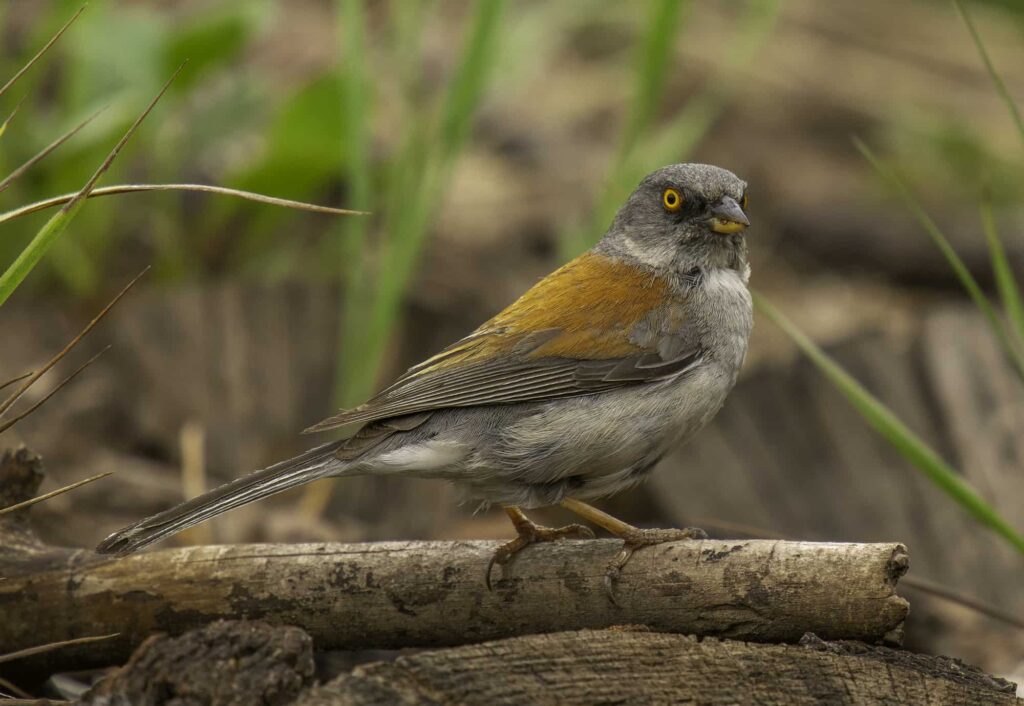With its combination of cactus-filled desserts, winding canyons, and sparse grasslands, Arizona is classic sparrow country. The state boasts more than 20 species of sparrow, and, because of its southerly position, some of them are hardly found anywhere else in North America.
Sparrows are great fun to watch feeding from your backyard, and the many species that spend the winter here may be grateful if you leave seeds out for them.
Because of the dry climate, sparrows in Arizona may also greatly benefit from bird baths or garden ponds where they can clean themselves and drink.
But whether you’re watching them from your bedroom window, or out in the desert among the cacti, we hope that this guide will help you to identify and learn more about these endearing birds.
Our list begins with the sparrows that you’re most likely to see in Arizona and ends with the rarest.
Identifying Sparrows in Arizona
White-crowned Sparrow
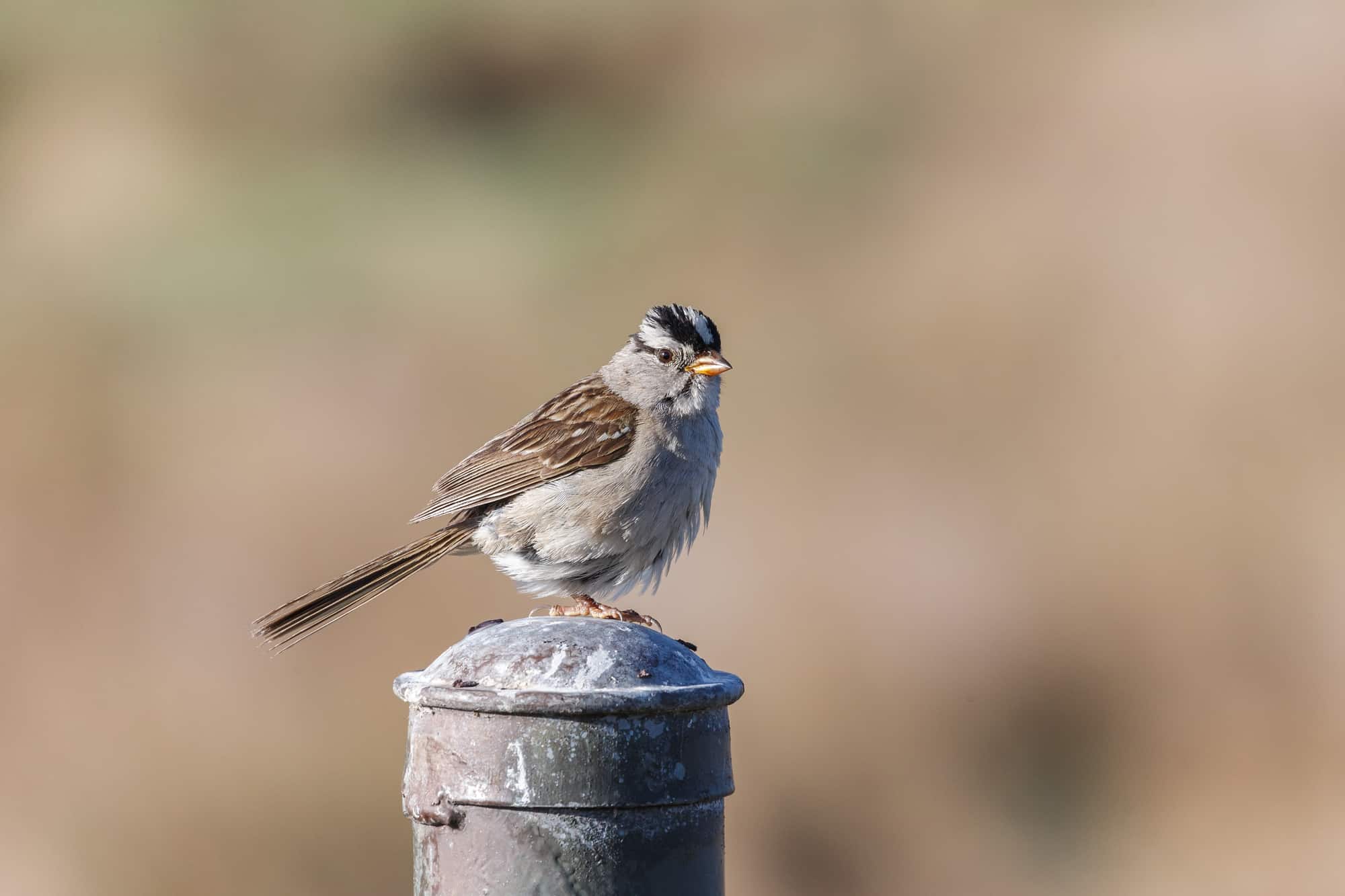
- Scientific Name: Zonotrichia leucophrys
- Length: 5.9-6.3 in (15-16 cm)
- Weight: 0.9-1.0 oz (25-28 g)
- Wingspan: 8.3-9.4 in (21-24 cm)
Despite being mostly winter migrants, White-crowned sparrows are the most frequently spotted sparrow in Arizona. A few birds do remain to breed here in the summer but the vast majority of birds fly to more northerly breeding grounds.
A medium-large sparrow, they are most easily recognized by their white and black-striped cap, and yellow bill. This species will happily feast on sunflower seeds offered from your backyard bird feeder.
Abert’s Towhee
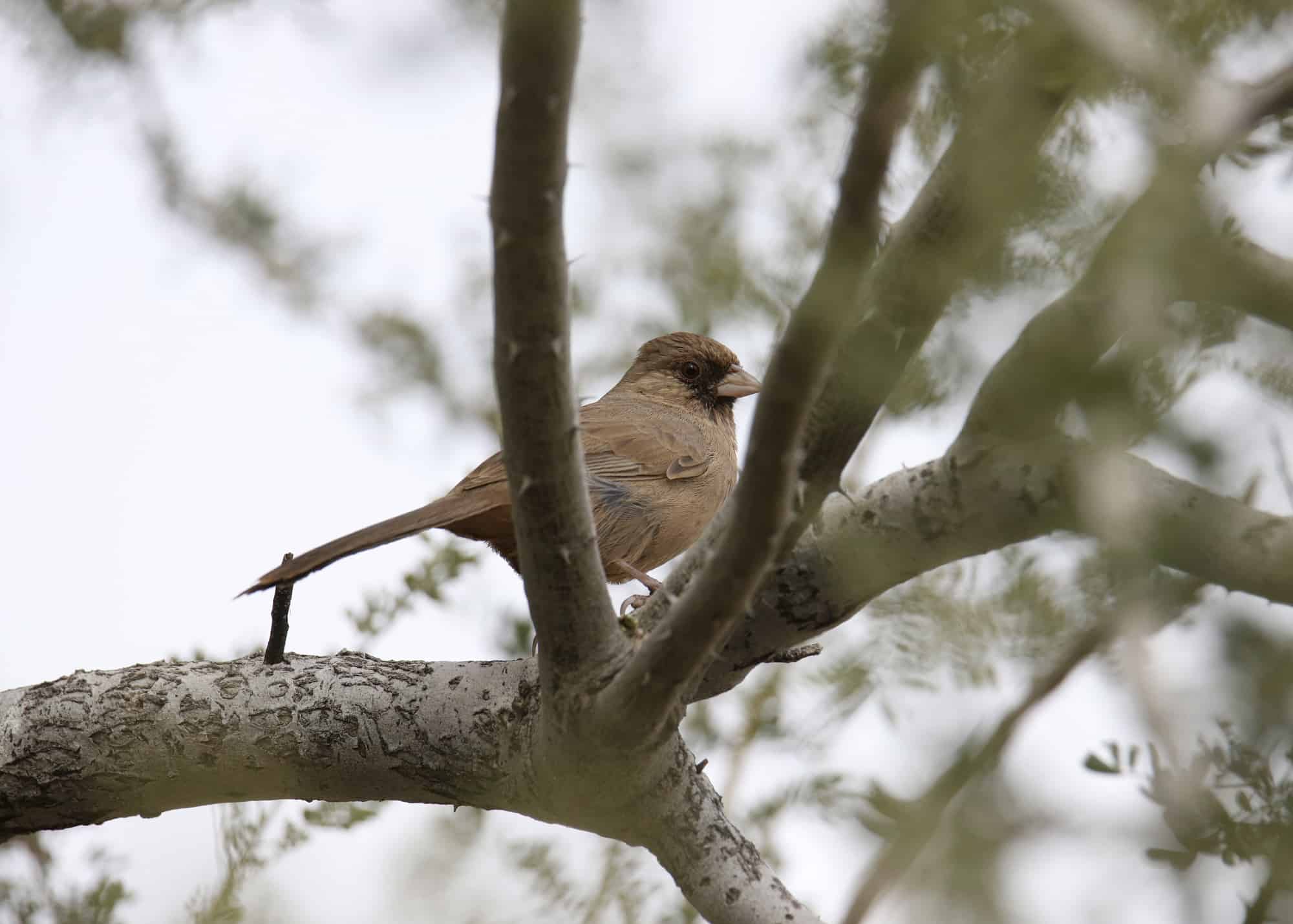
- Scientific Name: Melozone aberti
- Length: 8.3-9.1 in (21.2-23.1 cm)
- Weight: 1.5-1.9 oz (42.5-54.9 g)
- Wingspan: 10.4-11.6 in (26.5-29.5 cm)
Weighing in at almost 2 ounces, Abert’s towhees are one of the largest sparrows in Arizona. Other than their large size, their other distinguishing features are their stout, finch-like bill, and long tail.
Perfectly suited to live in Arizona, Abert’s towhees prefer arid environments but can often be seen near water. You can attract them to your backyard by offering them a pond or a bird bath – very valuable contributions to many of the other birds that live here too!
You’re more likely to see Abert’s towhees during the winter than summer in Arizona, but a large number also remain to nest here.
House Sparrow
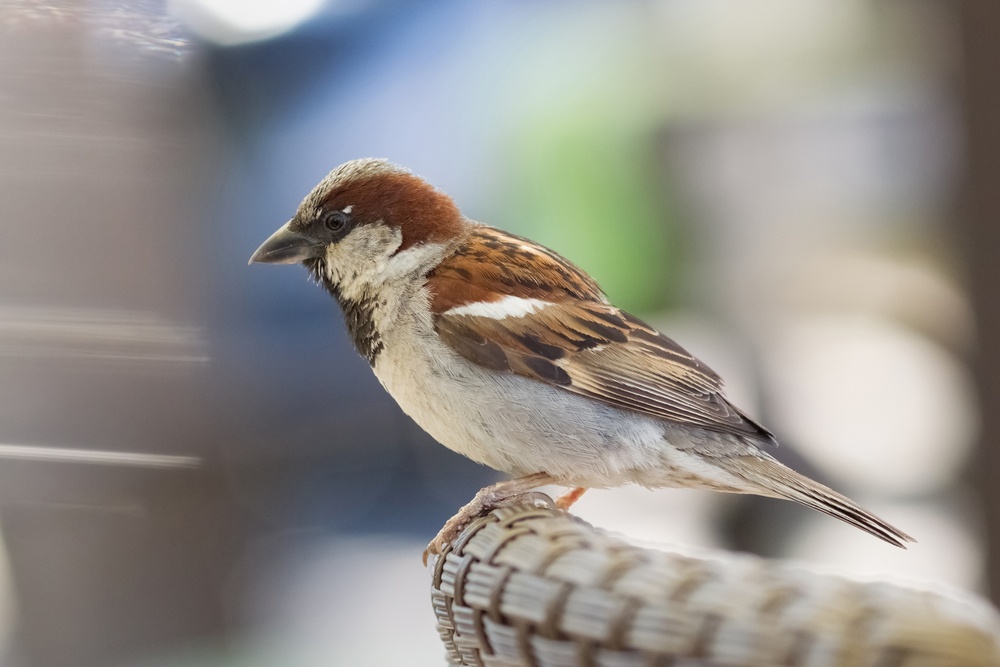
- Scientific Name: Passer domesticus
- Length: 5.9-6.7 in (15-17 cm)
- Weight: 0.9-1.1 oz (27-30 g)
- Wingspan: 7.5-9.8 in (19-25 cm)
House sparrows were introduced to New York City in 1852 by Europeans, but their populations quickly spread throughout most of America.
Unlike most native sparrows, house sparrows are sedentary birds that don’t migrate. This causes problems for local bird species because house sparrows often dominate the nesting grounds that would have otherwise been used by native birds.
Despite being an invasive species, the cheerful chirps of this medium-sized sparrow can lift one’s spirits on winter days. They’re an enthusiastic visitor to backyard feeders too.
Dark-eyed Junco
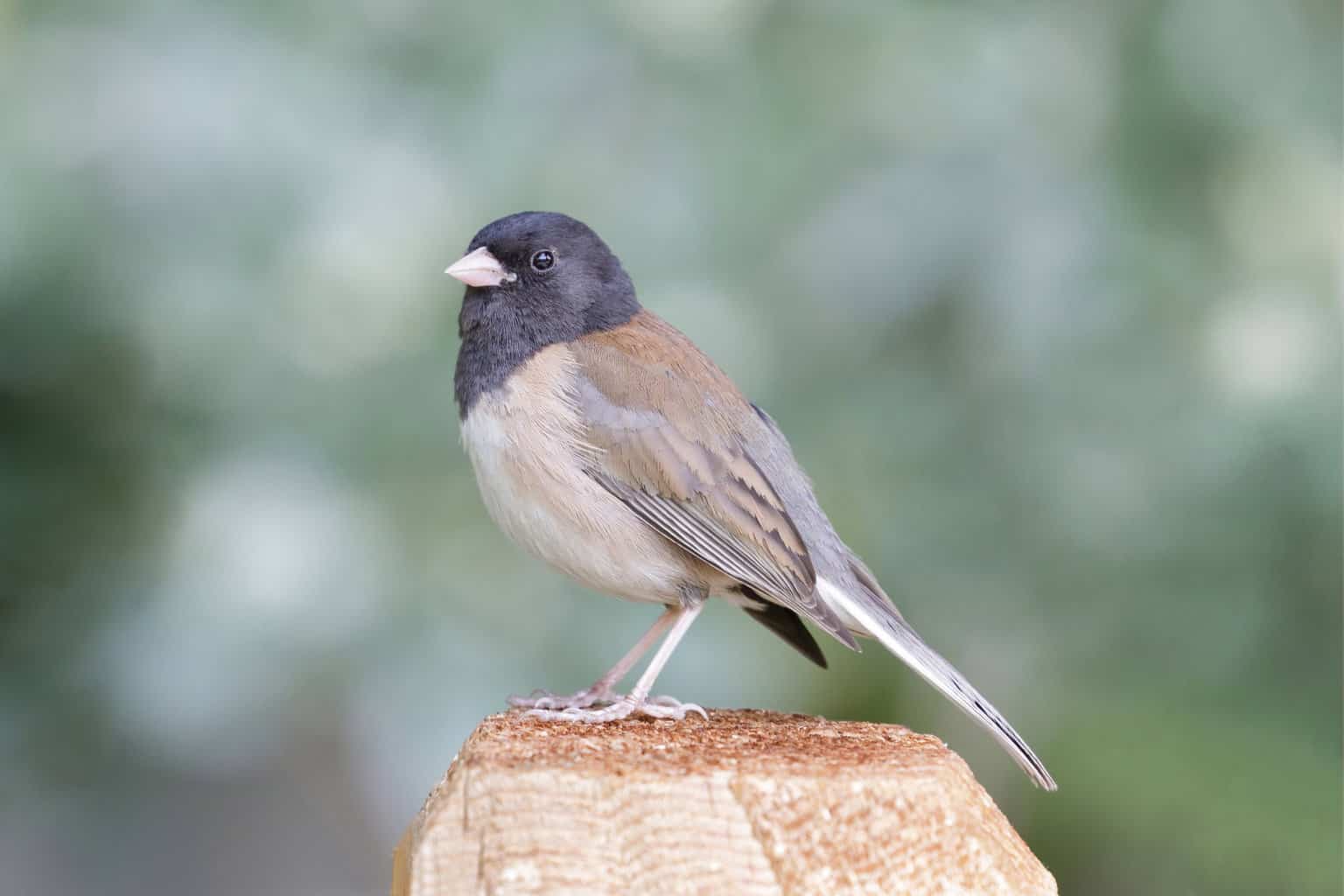
- Scientific Name: Junco hyemalis
- Length: 5.5-6.3 in (14-16 cm)
- Weight: 0.6-1.1 oz (18-30 g)
- Wingspan: 7.1-9.8 in (18-25 cm)
Not always thought of as a sparrow, dark-eyed juncos are, in fact, one of the most common members of the New World sparrow family. Unlike the slate-colored eastern subspecies, the dark-eyed juncos you see in Arizona are more likely to have brown, white, and black plumage.
A common sight in winter, most dark-eyed juncos migrate to the north to breed for summer, but a few of them remain in Arizona, meaning it’s possible to see this sparrow year-round.
Song Sparrow

- Scientific Name: Melospiza melodia
- Length: 4.7-6.7 in (12-17 cm)
- Weight: 0.4-1.9 oz (12-53 g)
- Wingspan: 7.1-9.4 in (18-24 cm)
Song sparrows are so-called mainly from the persistence with which they sing, rather than for having virtuoso abilities! Indeed, this plain-looking bird is most easily recognized by its voice.
Song sparrows can be seen both in the country and in towns, and scientists have discovered that this species can change its song according to its location!
You’re only slightly more likely to see song sparrows in Arizona during winter than summer since large numbers of them also remain to breed in the state.
Chipping Sparrow
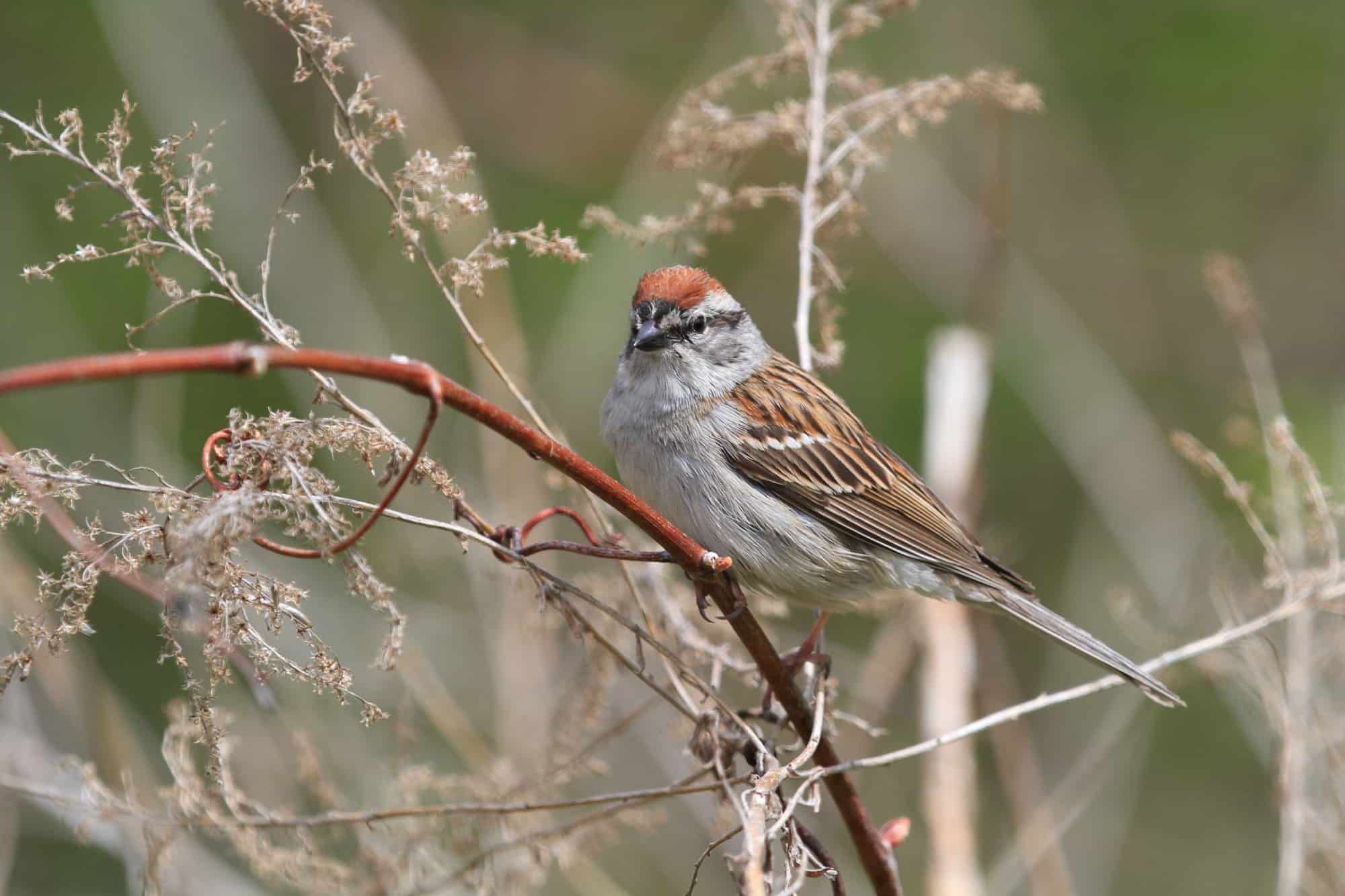
- Scientific Name: Spizella passerina
- Length: 4.7-5.9 in (12-15 cm)
- Weight: 0.4-0.6 oz (11-16 g)
- Wingspan: 8.3 in (21 cm)
Chipping sparrows are another bird named after their voice. Their sharp chips and staggered trill are a good way to identify this bird from afar. Upon closer inspection, you’ll also notice the chipping sparrows’ rusty red crown feathers, black eye line, and light gray breast.
Bird-watching reports have revealed you’re about twice as likely to see chipping sparrows during the winter than in summer in Arizona, but some do remain here all year, building nests in shrubs and small trees, and can raise up to three broods in a single year.
Black-throated Sparrow

- Scientific Name: Amphispiza bilineata
- Length: 4.7-5.5 in (12-14 cm)
- Weight: 0.4-0.5 oz (11-15 g)
- Wingspan: 7.7 in (19.5 cm)
The black-throated sparrow could have also been called the black-headed sparrow. Its black head and throat are broken only by two distinctive white stripes on either side of its eye. This contrasts nicely with the bird’s light gray chest.
You’re most likely to see this bird foraging in desert scrub and sagebrush habitats. Omnipresent year-round in Arizona, they mostly feed on insects during the summer and seeds in winter.
Spotted Towhee
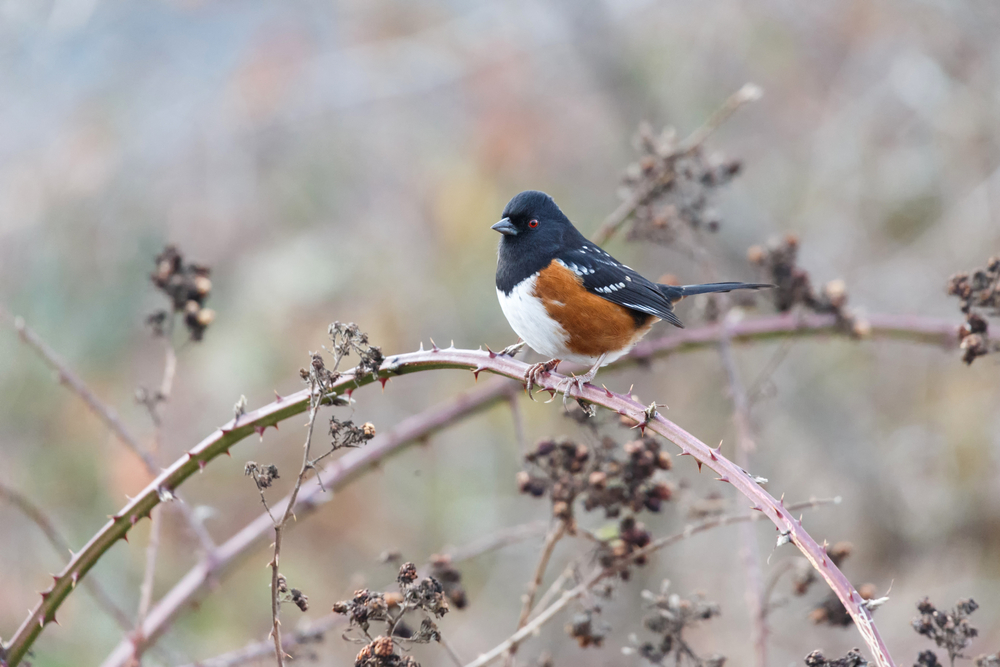
- Scientific Name: Pipilo maculatus
- Length: 6.7-8.3 in (17-21 cm)
- Weight: 1.2-1.7 oz (33-49 g)
- Wingspan: 11.0 in (28 cm)
Spotted towhees are one of the largest and also most beautiful of all sparrows in Arizona. Their red chest, spotted wings, red eyes, and long tails make this bird unmistakable for any other.
You will often hear these powerful sparrows before you see them, as they scratch around in the undergrowth looking for food.
These birds are slightly more common in the state during summer than winter, when they nest on or close to the ground. During winter you can attract them to your garden by offering them Black Oil Sunflower seeds, Millet, and Milo.
Canyon Towhee
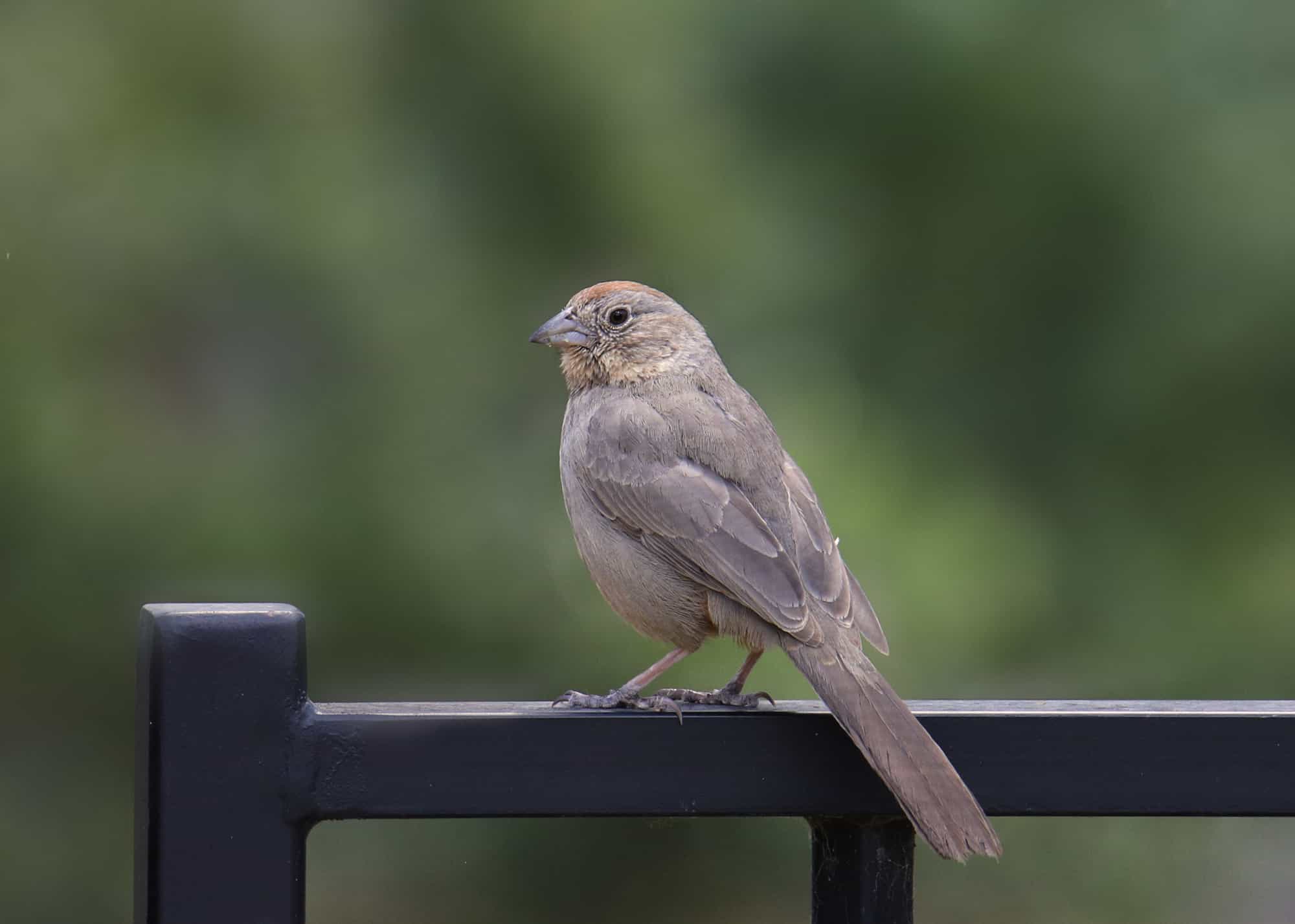
- Scientific Name: Melozone fusca
- Length: 8.3-9.8 in (21-25 cm)
- Weight: 1.3-1.9 oz (37-53 g)
- Wingspan: 11.5 in (29.21 cm)
Another large sparrow, the Canyon Towhees is very plain-colored, making it difficult to identify by sight. With some practice, however, you can distinguish them from other sparrows by their sheer size, and rapid, two-toned song.
These birds can be seen year-round in Arizona, but are slightly more common during the breeding season when you can find them nesting near the base of trees and shrubs.
These mysterious birds can occasionally be coaxed to your backyard bird feeder during winter. Some individuals appear to be very shy, while others are bold and seem unafraid of human contact.
Lincoln’s Sparrow
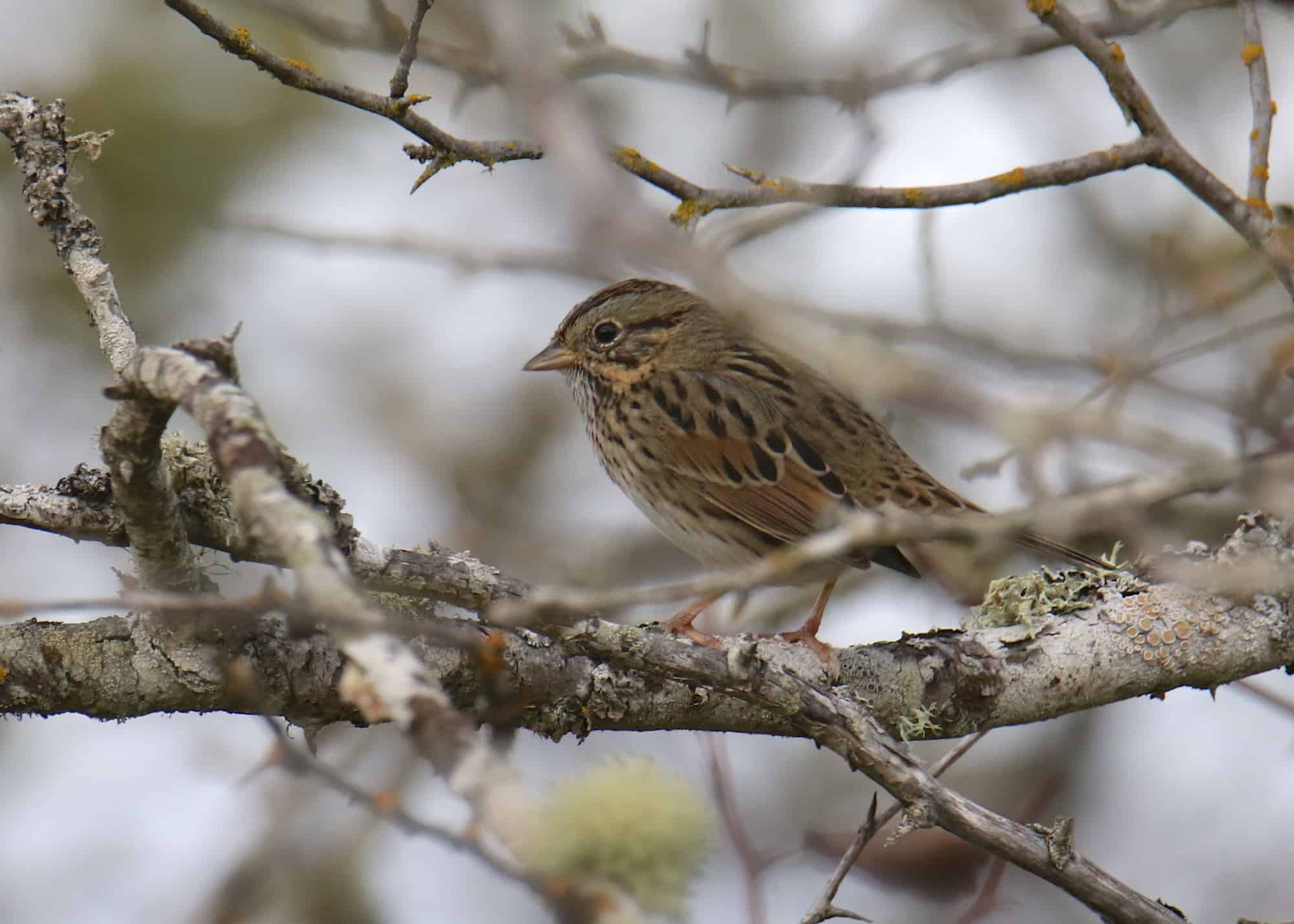
- Scientific Name: Melospiza lincolnii
- Length: 5.1-5.9 in (13-15 cm)
- Weight: 0.6-0.7 oz (17-19 g)
- Wingspan: 7.5-8.7 in (19-22 cm)
Lincoln’s sparrows are winter migrants in Arizona when they return from Canada and the Western United States to take advantage of the state’s mild climate.
Although they’re difficult to distinguish from other sparrows by sight, this species has a particularly endearing song that consists of cheerful phrases interspersed with silence.
Lark Sparrow
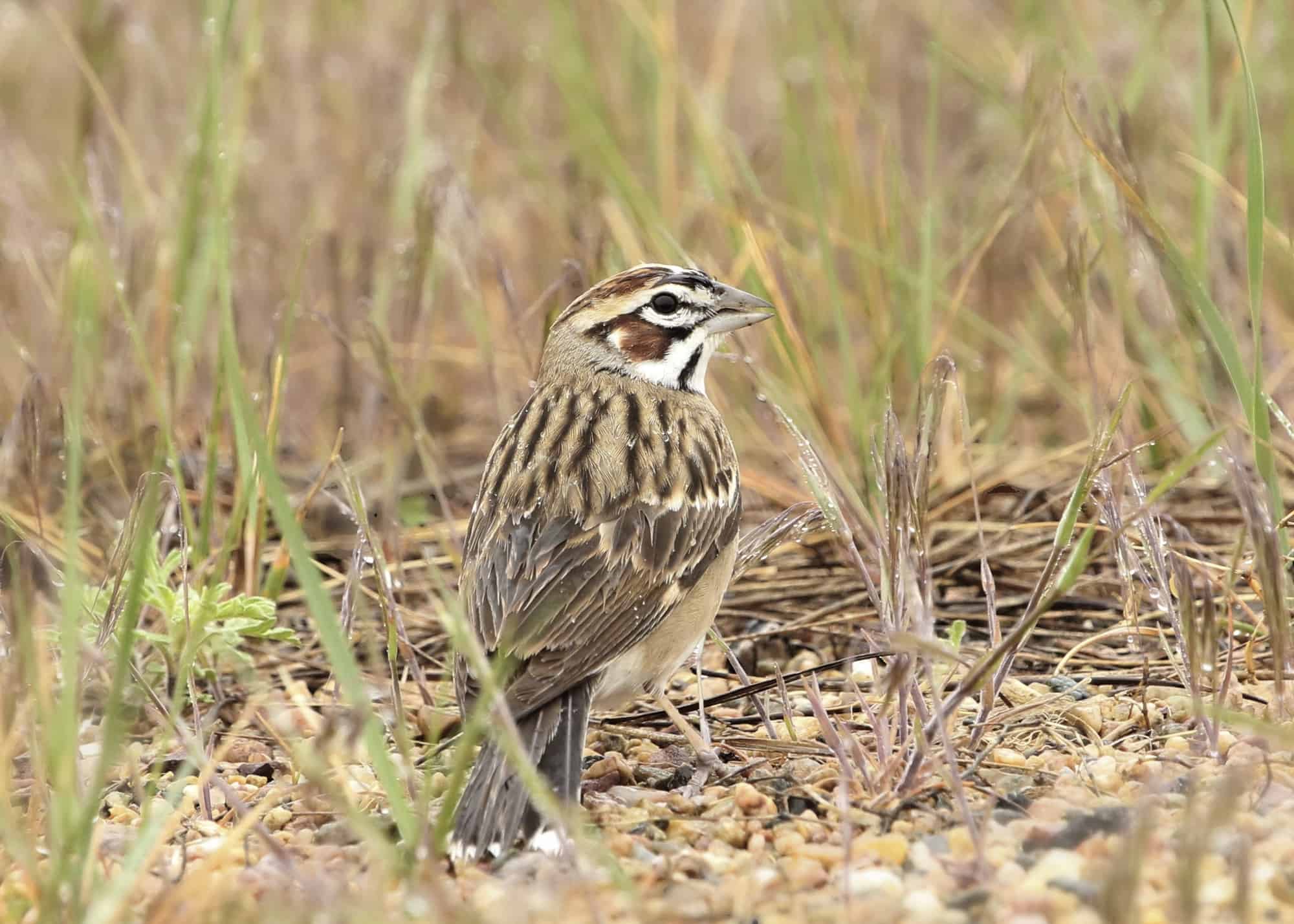
- Scientific Name: Chondestes grammacus
- Length: 5.9-6.7 in (15-17 cm)
- Weight: 0.8-1.2 oz (24-33 g)
- Wingspan: 11.0 in (28 cm)
With their brown and white striped head, white belly, and white-edged tail, lark sparrows are relatively easy to identify. You tend to find these large sparrows in open grassland interspersed with trees and shrubs.
Lark sparrows are equally common during summer and winter in Arizona, where they can be found feeding on insects, grass seeds, and vegetation according to what’s seasonally available.
Rufous-winged Sparrow

- Scientific Name: Peucaea carpalis
- Length: 15 cm ( 5.75 in)
- Weight: 14 g (0.5 oz)
- Wingspan: 21 cm (8.25 in)
Rufous-winged sparrows are small, sedentary birds and remain in the south of Arizona throughout the year. They can be recognized by their rusty red eyeline and rufous crown. Closer inspection also reveals a black ‘mustache’ on their chins!
These shy desert birds can be difficult to spot and typically tuck their nests away among cacti and thorny bushes to protect them from potential predators.
Green-tailed Towhee
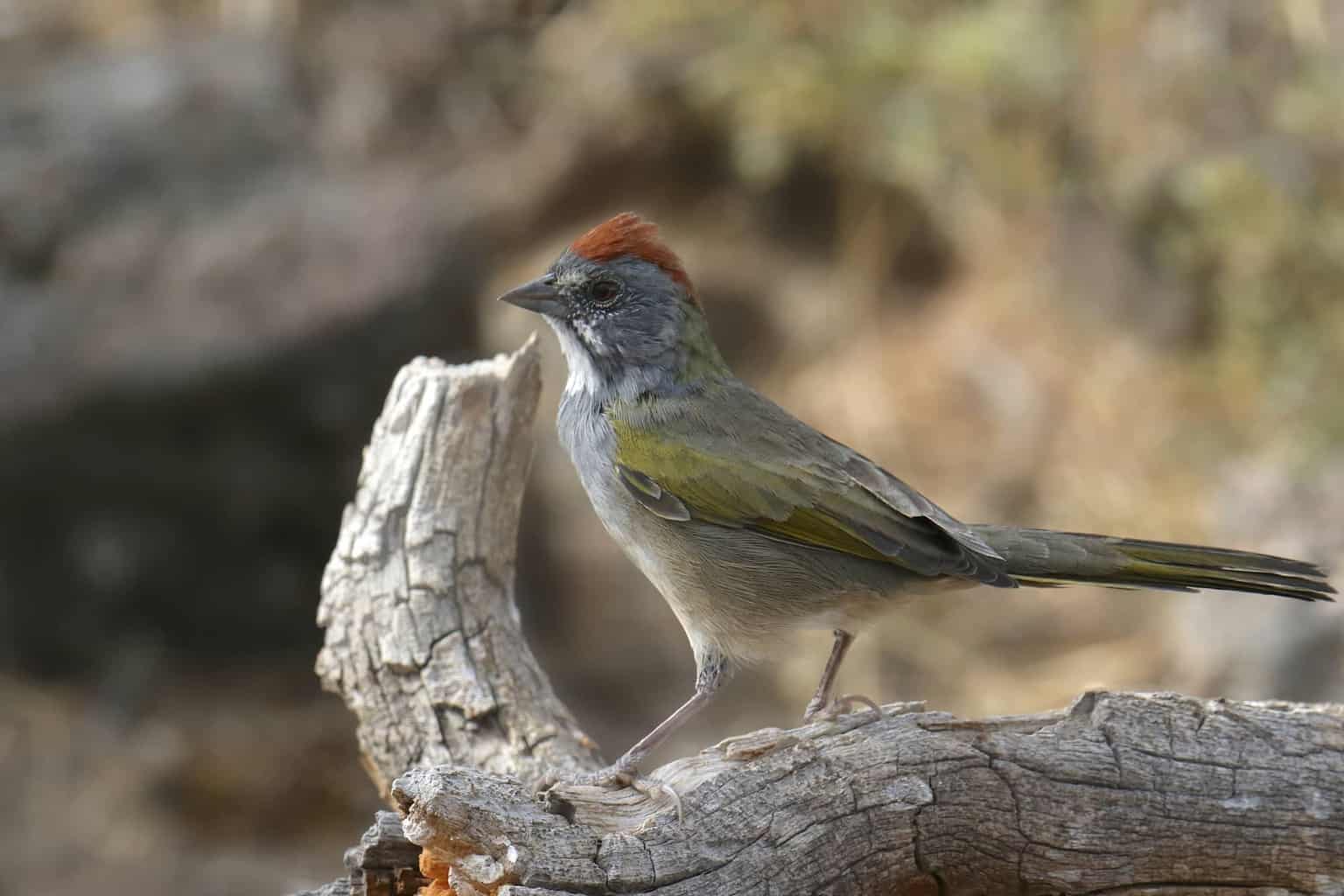
- Scientific Name: Pipilo chlorurus
- Length: 7.25 in (18.4 cm)
- Weight: 0.8-1.4 oz (21.5-39.4 g)
- Wingspan: 10 inches
Green-tailed towhees are beautiful-looking birds with rusty red crowns and green-tinted feathers upon their wings and tails.
In winter, these warmth-loving birds tend to remain in the mild southern half of Arizona. In summer, some of them scatter out to nest all around the state, whereas others move into other parts of the western mountains for the breeding season.
Brewer’s Sparrow
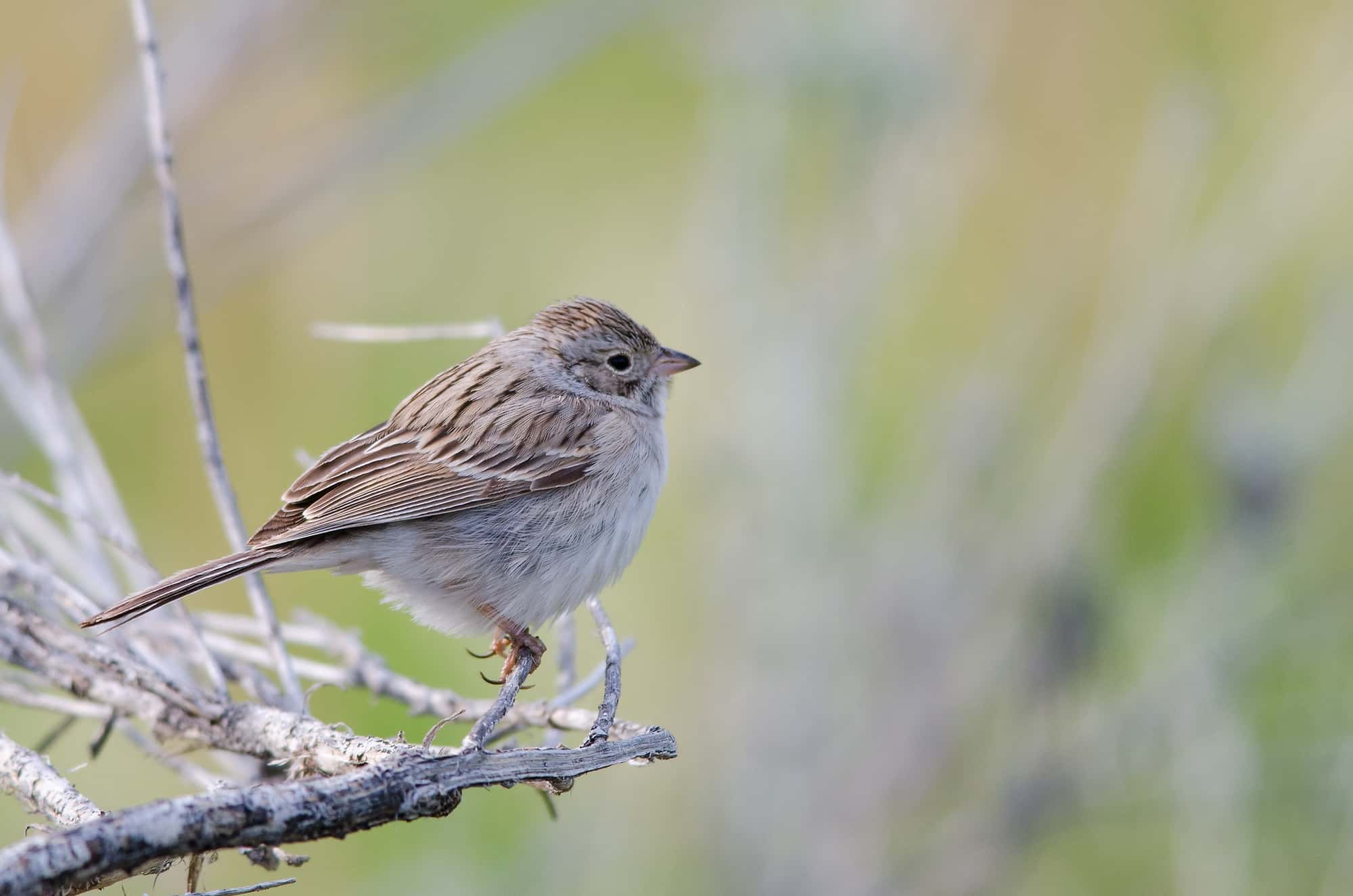
- Scientific Name: Spizella breweri
- Length: 5.1-5.9 in (13-15 cm)
- Weight: 0.4-0.5 oz (11-14 g)
- Wingspan: 7.1-7.9 in (18-20 cm)
A cousin of the chipping sparrow, but often weighing less than half an ounce, Brewer’s sparrows are the smallest sparrow not only in Arizona but in all of North America.
Chiefly a winter migrant, some Brewer’s sparrows fly as far north as Alaska for the breeding season! A very small number of them, however, can be found nesting in Arizona and are noted for how fiercely they defend their nests – sometimes even chasing away large raptors!
Apart from their diminutive size, Brewer’s sparrows are most easily recognized by their notched tails and buzzy notes in their song.
Yellow-eyed Junco
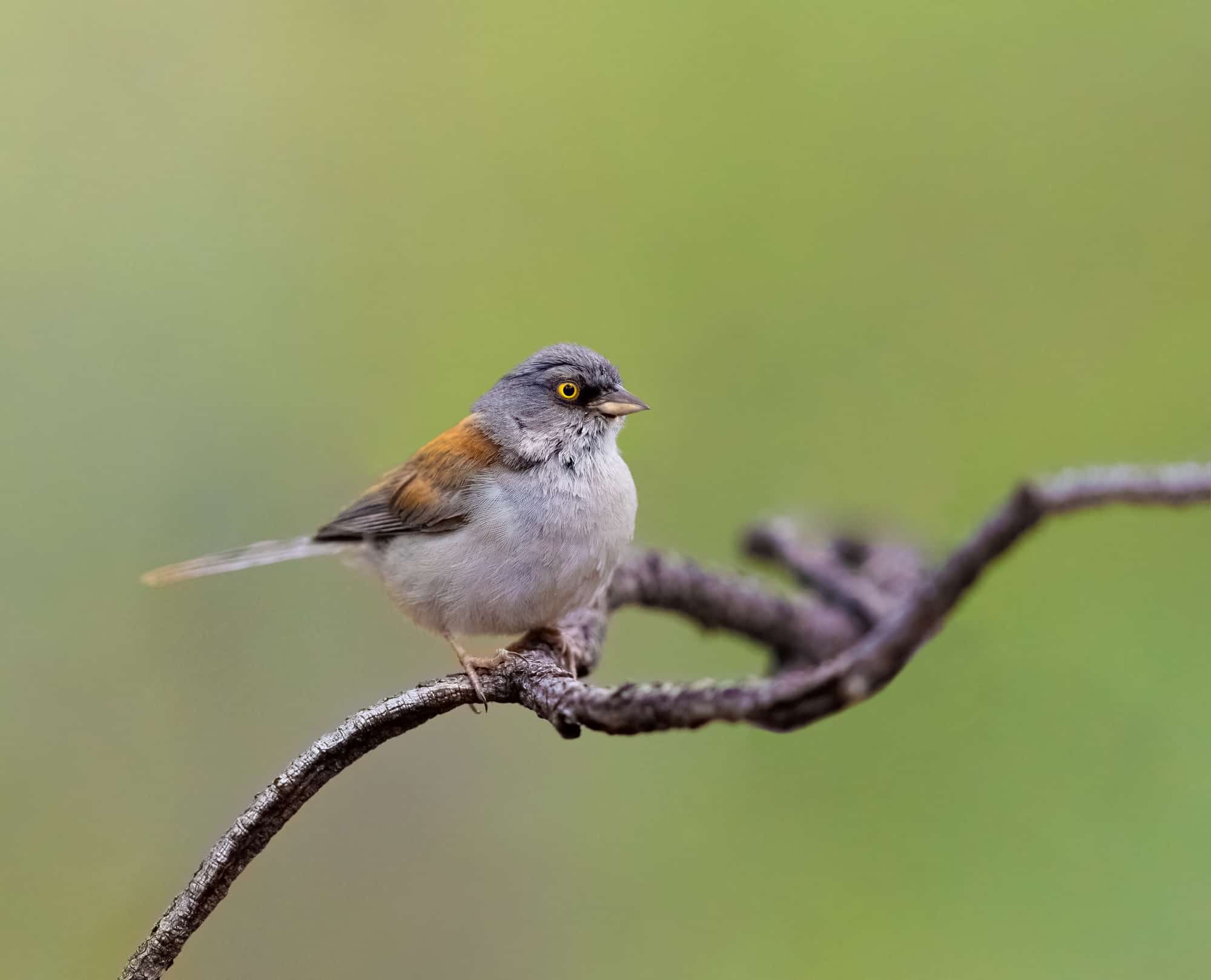
- Scientific Name: Junco phaeonotus
- Length: 16 cm ( 6.25 in)
- Weight: 20 g (0.7 oz)
- Wingspan: 25 cm (9.75 in)
With their almost luminous golden eyes, the yellow-eyed juncos name perfectly fits the stand-out feature of this striking-looking bird. The dark feathers surrounding its eyes and rusty red plumage on its back are set against various shades of gray that make up the rest of its body.
Primarily native to Mexico, southeast Arizona, and southwest New Mexico are the only two regions where you can typically find this bird in the United States, where small populations remain throughout the year.
Rufous-crowned Sparrow
- Scientific Name: Aimophila ruficeps
- Length: 5.9-6.3 in (15-16 cm)
- Weight: 0.6-0.7 oz (16-21 g)
- Wingspan: 7.5-8 inches (19-21cm)
The rufous-crowned sparrow is also sometimes known as the ‘rock sparrow’ because of its affinity with rocky habitats. These birds don’t migrate, and instead, tend to remain in established territories that they defend from other birds.
Their reddish-brown crown stripes and black lateral throat stripes make them fairly easy to identify. They can be found throughout most of Arizona except for the northeast.
Vesper Sparrow
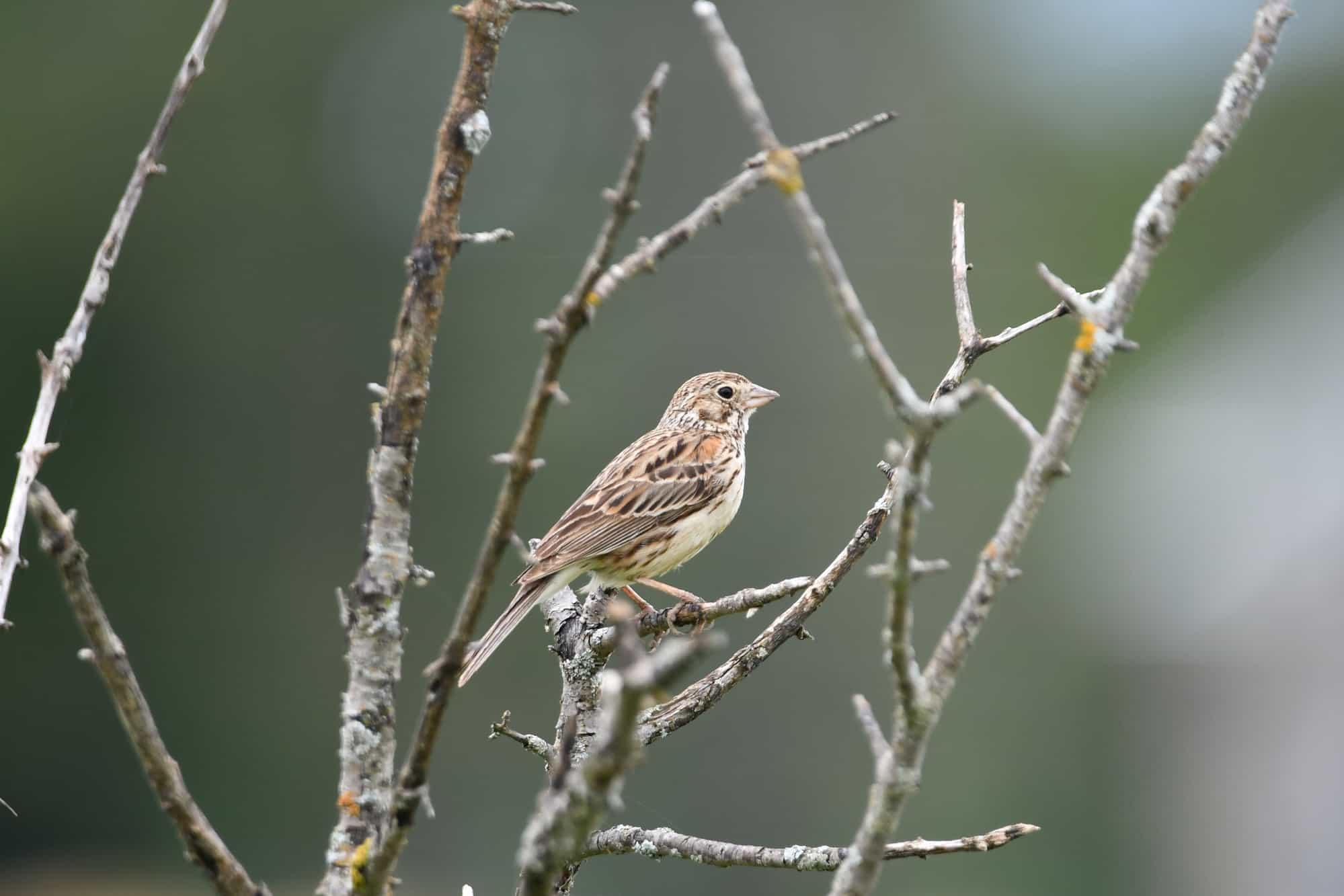
- Scientific Name: Pooecetes gramineus
- Length: 5.1-6.3 in (13-16 cm)
- Weight: 0.7-1.0 oz (20-28 g)
- Wingspan: 9.4 in (24 cm)
Along with its white chest and stout bill, the best way to identify Vesper sparrows is their fast-trilling call that carries through the grassy plains and meadows that they inhabit.
They’re mainly seen through wintertime in Arizona since their main breeding grounds are in the northern half of the United States and Canada.
The sparrow species is omnivorous, feeding mainly on insects, spiders, weeds, and grass seeds.
Savannah Sparrow
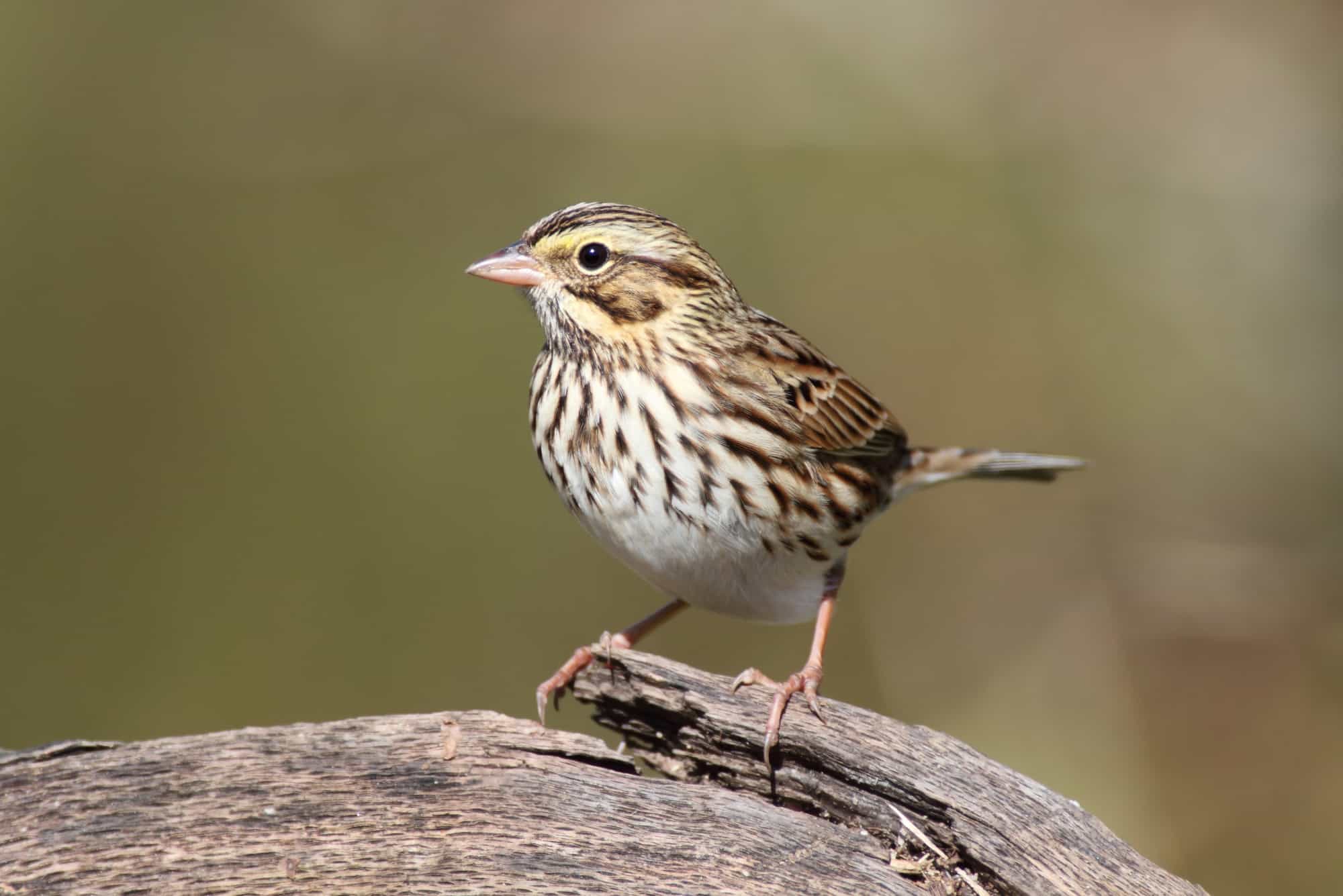
- Scientific Name: Passerculus sandwichensis
- Length: 4.3-5.9 in (11-15 cm)
- Weight: 0.5-1.0 oz (15-28 g)
- Wingspan: 7.9-8.7 in (20-22 cm
Savannah sparrows are mostly seen in the south and west parts of Arizona during winter, but during summer, small populations remain to breed in the northeast of the state.
This bird has an amazingly large breeding range in North America which extends well up into the arctic circle!
Savannah sparrows can mostly be seen in low grassland, especially enjoying habitats that are grazed by animals. Seventeen subspecies of this sparrow are now recognized by ornithologists, making this one of the most genetically diverse sparrow species!
Lark Bunting
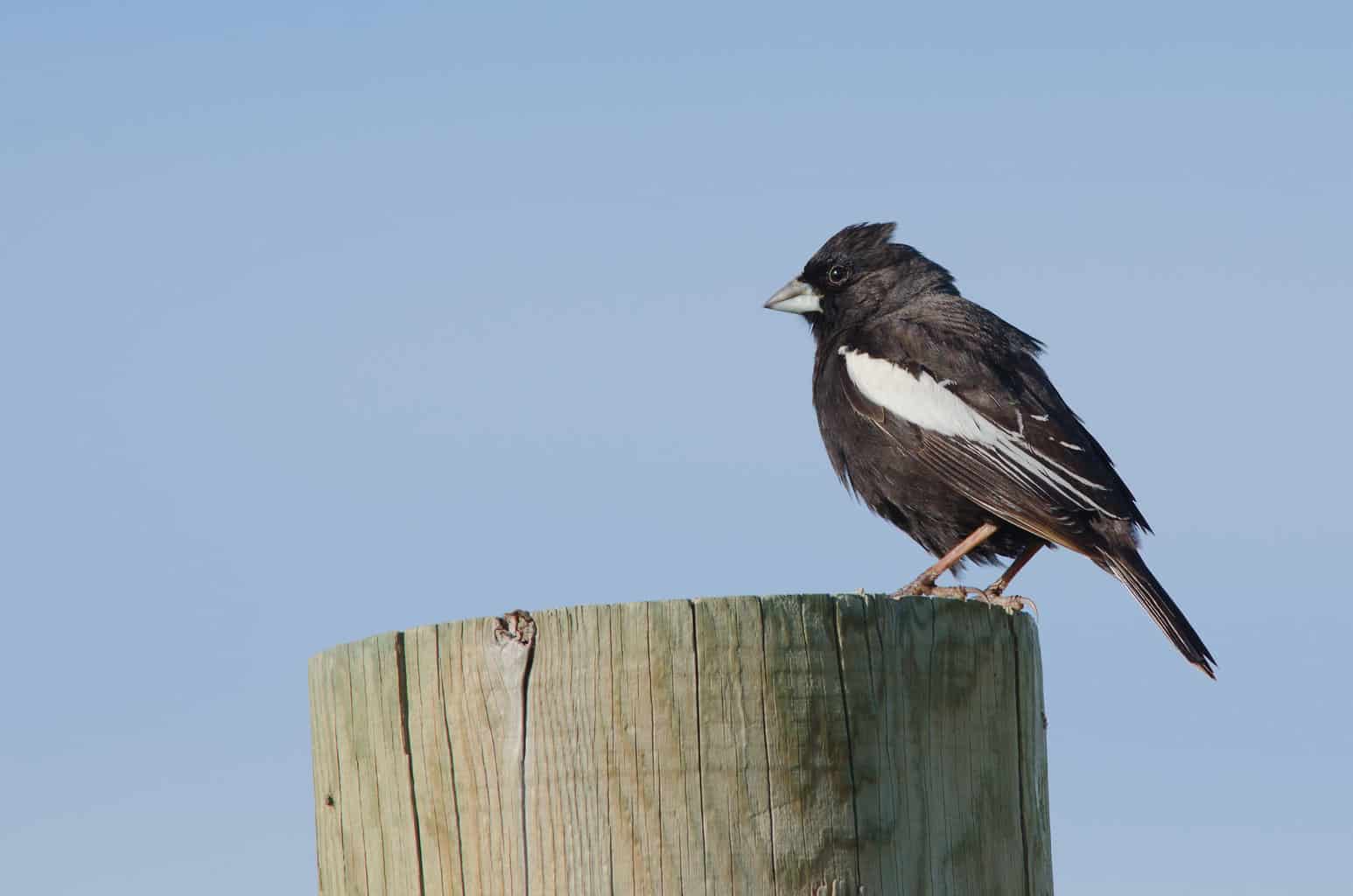
- Scientific Name: Calamospiza melanocorys
- Length: 5.5-7.1 in (14-18 cm)
- Weight: 1.3-1.5 oz (35.3-41.3 g)
- Wingspan: 9.8-11.0 in (25-28 cm)
Lark buntings are a fairly rare sight in Arizona, and only inhabit the southern half of the state during the winter.
Males make one of the most striking of all sparrow species during the breeding season, when their plumage turns jet black, contrasted only by white patches on their wings and at the tips of their tails.
Sadly, you’re unlikely to see this impressive sight much in Arizona, except for in March, when the bird is changing color and preparing for its flight to more northerly breeding grounds.
There are no other birds that appear quite like a lark bunting and genetic evaluations have confirmed that the bird has no close relatives in the sparrow family.
Black-chinned Sparrow
- Scientific Name: Spizella atrogularis
- Length: 15 cm (5.75 in)
- Weight: 11 g (0.4 oz)
- Wingspan: 23 cm (9 in)
Black-chinned sparrows nest across central and northwest Arizona and overwinter in the south. They are not very common birds in Arizona, however, only being seen by around 1% of birdwatchers throughout the year.
The black feathers which give this bird its name not only form on the bird’s chin but above its beak too. Another defining feature is the bird’s long tail.
Since the 1960s, the black-chinned sparrow’s numbers have rapidly declined but thankfully the bird is now protected by the Migratory Bird Treaty Act.
Botteri’s Sparrow
- Scientific Name: Peucaea botterii
- Length: 6 in (15-16cm)
- Weight: 0.7 oz (19-20g)
- Wingspan: 9 inches (22-23cm)
Arizona is the only state other than Texas where you can find Botteri’s sparrow. The rest of the population resides in Mexico and Central America.
Between the 1890s and mid-1900s, intensive livestock grazing meant that you could no longer see this bird in Arizona. Thankfully, thickets of dense shrubs and bio-diverse weedy fields were allowed to recover and the Botteri’s sparrow returned! It seems that this undervalued type of habitat is especially critical to its young during fledging.
This sparrow may be plain to look at, but it has a remarkable voice, consisting of short chirps combined with impressively long trills.
Cassin’s Sparrow
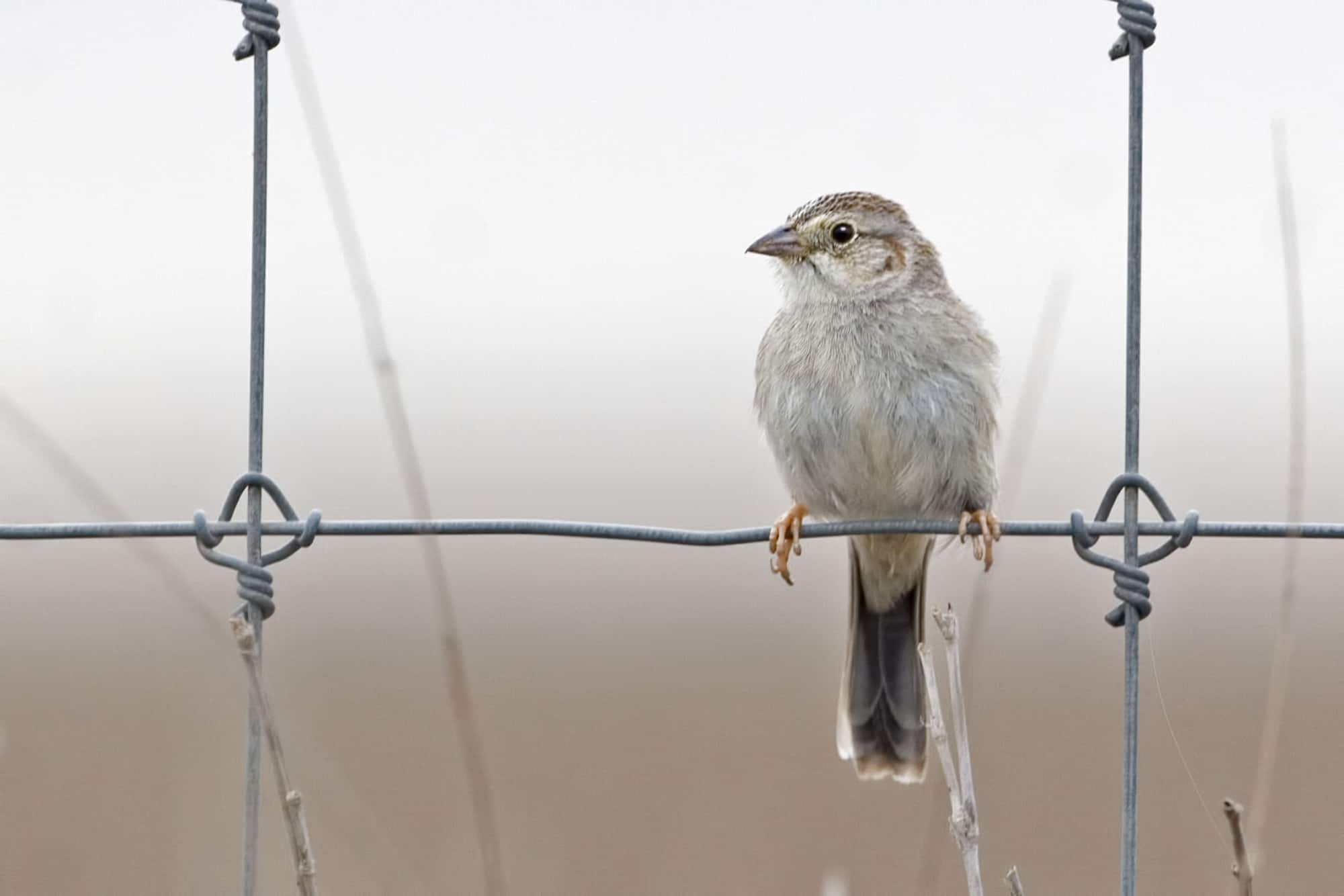
- Scientific Name: Peucaea cassinii
- Length: 5.1-5.9 in (13-15 cm)
- Weight: 0.6-0.7 oz (16-21 g)
- Wingspan: 7.9 in (20 cm)
Cassin’s sparrows are small desert-loving birds and are seen most often during the breeding season in Arizona. Nonetheless, they are rare birds in the state.
Their tunnel-like nests are made of grass, roots, animal hair, and even flowers, and are often placed at the foot of cacti.
A distinctive feature that might help you recognize this bird is the way it sings its song while gliding down from high in the sky during the breeding season.
Conclusion
Whether you’re enjoying watching great flocks of white-crowned sparrows descending on your bird feeders, or trying to catch a glimpse of the rare Botteri’s sparrow among the southern scrubland, there are endless opportunities to encounter these cheerful birds in Arizona.
Although habitat loss has caused some species to decline, we can hope that protective measures alongside better-informed public awareness will help to preserve these underappreciated birds for generations to come.
It’s not only sparrows that are abundant in Arizona, though, so don’t forget to check out our guide to 31 of the most exciting bird species in The Grand Canyon State here.

